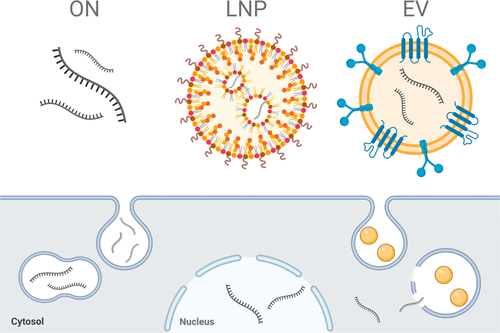Our official English website, www.x-mol.net, welcomes your
feedback! (Note: you will need to create a separate account there.)
Delivery of Oligonucleotide Therapeutics: Chemical Modifications, Lipid Nanoparticles, and Extracellular Vesicles
ACS Nano ( IF 15.8 ) Pub Date : 2021-09-10 , DOI: 10.1021/acsnano.1c05099 Jeremy P Bost 1 , Hanna Barriga 2 , Margaret N Holme 2 , Audrey Gallud 3, 4 , Marco Maugeri 5 , Dhanu Gupta 1 , Taavi Lehto 1, 6 , Hadi Valadi 5 , Elin K Esbjörner 3 , Molly M Stevens 2, 7 , Samir El-Andaloussi 1
ACS Nano ( IF 15.8 ) Pub Date : 2021-09-10 , DOI: 10.1021/acsnano.1c05099 Jeremy P Bost 1 , Hanna Barriga 2 , Margaret N Holme 2 , Audrey Gallud 3, 4 , Marco Maugeri 5 , Dhanu Gupta 1 , Taavi Lehto 1, 6 , Hadi Valadi 5 , Elin K Esbjörner 3 , Molly M Stevens 2, 7 , Samir El-Andaloussi 1
Affiliation

|
Oligonucleotides (ONs) comprise a rapidly growing class of therapeutics. In recent years, the list of FDA-approved ON therapies has rapidly expanded. ONs are small (15–30 bp) nucleotide-based therapeutics which are capable of targeting DNA and RNA as well as other biomolecules. ONs can be subdivided into several classes based on their chemical modifications and on the mechanisms of their target interactions. Historically, the largest hindrance to the widespread usage of ON therapeutics has been their inability to effectively internalize into cells and escape from endosomes to reach their molecular targets in the cytosol or nucleus. While cell uptake has been improved, “endosomal escape” remains a significant problem. There are a range of approaches to overcome this, and in this review, we focus on three: altering the chemical structure of the ONs, formulating synthetic, lipid-based nanoparticles to encapsulate the ONs, or biologically loading the ONs into extracellular vesicles. This review provides a background to the design and mode of action of existing FDA-approved ONs. It presents the most common ON classifications and chemical modifications from a fundamental scientific perspective and provides a roadmap of the cellular uptake pathways by which ONs are trafficked. Finally, this review delves into each of the above-mentioned approaches to ON delivery, highlighting the scientific principles behind each and covering recent advances.
中文翻译:

寡核苷酸治疗药物的递送:化学修饰、脂质纳米颗粒和细胞外囊泡
寡核苷酸 (ON) 是一类快速增长的治疗药物。近年来,FDA 批准的 ON 疗法名单迅速扩大。ON 是基于小核苷酸(15-30 bp)的疗法,能够靶向 DNA 和 RNA 以及其他生物分子。根据其化学修饰和靶标相互作用机制,ON 可以分为几类。从历史上看,ON疗法广泛使用的最大障碍是它们无法有效地内化到细胞中并逃离内体以到达细胞质或细胞核中的分子靶点。虽然细胞摄取有所改善,但“内体逃逸”仍然是一个重大问题。有多种方法可以克服这一问题,在本次综述中,我们重点关注三种方法:改变 ON 的化学结构,配制合成的基于脂质的纳米颗粒来封装 ON,或通过生物方式将 ON 加载到细胞外囊泡中。本综述提供了 FDA 批准的现有 ON 的设计和作用模式的背景。它从基础科学角度介绍了最常见的 ON 分类和化学修饰,并提供了 ON 运输的细胞摄取途径的路线图。最后,本综述深入研究了上述每种 ON 交付方法,强调了每种方法背后的科学原理并涵盖了最新进展。
更新日期:2021-09-28
中文翻译:

寡核苷酸治疗药物的递送:化学修饰、脂质纳米颗粒和细胞外囊泡
寡核苷酸 (ON) 是一类快速增长的治疗药物。近年来,FDA 批准的 ON 疗法名单迅速扩大。ON 是基于小核苷酸(15-30 bp)的疗法,能够靶向 DNA 和 RNA 以及其他生物分子。根据其化学修饰和靶标相互作用机制,ON 可以分为几类。从历史上看,ON疗法广泛使用的最大障碍是它们无法有效地内化到细胞中并逃离内体以到达细胞质或细胞核中的分子靶点。虽然细胞摄取有所改善,但“内体逃逸”仍然是一个重大问题。有多种方法可以克服这一问题,在本次综述中,我们重点关注三种方法:改变 ON 的化学结构,配制合成的基于脂质的纳米颗粒来封装 ON,或通过生物方式将 ON 加载到细胞外囊泡中。本综述提供了 FDA 批准的现有 ON 的设计和作用模式的背景。它从基础科学角度介绍了最常见的 ON 分类和化学修饰,并提供了 ON 运输的细胞摄取途径的路线图。最后,本综述深入研究了上述每种 ON 交付方法,强调了每种方法背后的科学原理并涵盖了最新进展。


















































 京公网安备 11010802027423号
京公网安备 11010802027423号